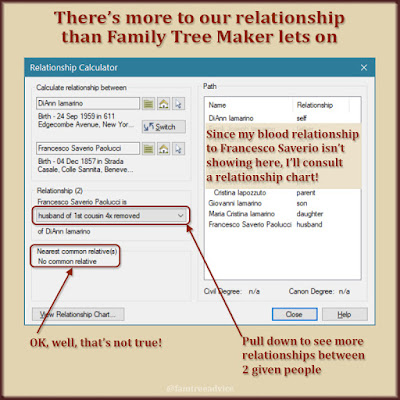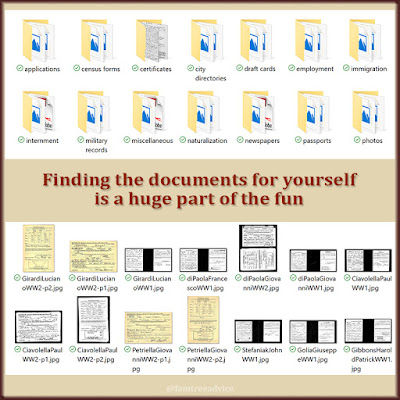If you don't have enough info to go on, imagine what that info ought to be.
I spent all day yesterday piecing together a family for Barbara. We began with a few basic facts. I knew her parents' names and her grandparents' names. I didn't have any dates, but I knew Barbara's approximate age.
Let me walk you through how I built out as many facts as possible from those basic facts.
Census Records Lead to One Another
First I wanted to find Barbara in a census or two. With only "New York City" as a location, I found her in the 1940 census. From that I learned the names and ages of her siblings.
Their names helped me be sure I had the right family when I found them in the 1915 and 1920 censuses. As the children grew up, I found that the parents were no longer together. At first I thought Barbara's father had died, but her mother was in one place and her father was in another. They had divorced.
Next I searched for earlier censuses when Barbara's parents were children.
Knowing when Barbara's grandparents were born, I found their marriage records. And some of their death records, which also provided their exact birth dates.
Searching for the Immigrant Ancestors
I'm the luckiest Italian American alive. My 2 grandfathers often told me the names of their hometowns in Italy. My ancestors came to America late enough for their ship manifests to be very detailed.
My 2 grandmothers were born in New York. But their parents arrived here in 1899 and 1906. Their ship manifests tell me their hometowns.
If your people came to the new country before the late 1890s, you may get no help from their ship manifest. That's when naturalization papers can fill in the gaps.
 |
| Ship manifests are not created equal. The late 1890s to 1920s are full of great information. |
But Barbara's grandfather's certificate of naturalization doesn't say where he came from. The dates on his papers helped me find his ship manifest, but there was a problem. He was the only one onboard from his town, and the town name was so generic.
Barbara said he was from southernmost Italy. There was no town with this name down south. I thought the town might have a longer name. I found a good possibility, but its 1880s birth and marriage records were destroyed! I've sent an email to the town asking for help. We'll see what they say.
But there was another immigrant to find. Barbara's paternal grandfather was born in New York in the 1890s. I didn't know who his immigrant father was. How could I go back another generation in Barbara's family tree?
That's when my big hunch came into play.
 |
| When the paper trail is out of your reach, make your best educated guess. |
Barbara's father was John and his father was Sylvester. His father should be Giovanni, right? And based on Sylvester's age, I thought "Giovanni" should have been born about 1865. That was my hunch.
But Giovanni and Cristina had come to America before 1889. Their ship manifests won't tell me their hometowns. I did find Giovanni's naturalization record from 1894. Now I had his exact birth date and a ship arrival date in 1881 (too early). Unfortunately, that date was an estimate, and there's no ship arriving on that date from Italy.
I may be stuck on finding the family's hometowns, but I was able to build out Barbara's family and make her very happy.
Have you been doing this genealogy thing for a while? I'll bet you know more than you give yourself credit for. If you've got a hunch, follow it through. It may lead you to a new generation.










